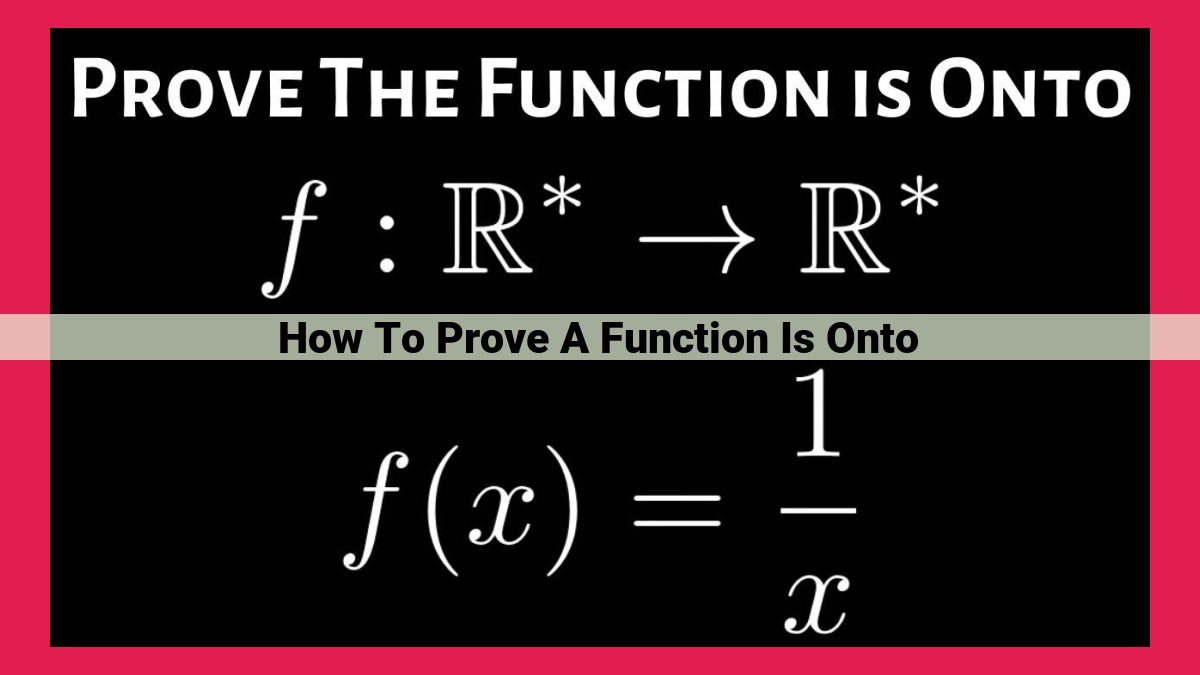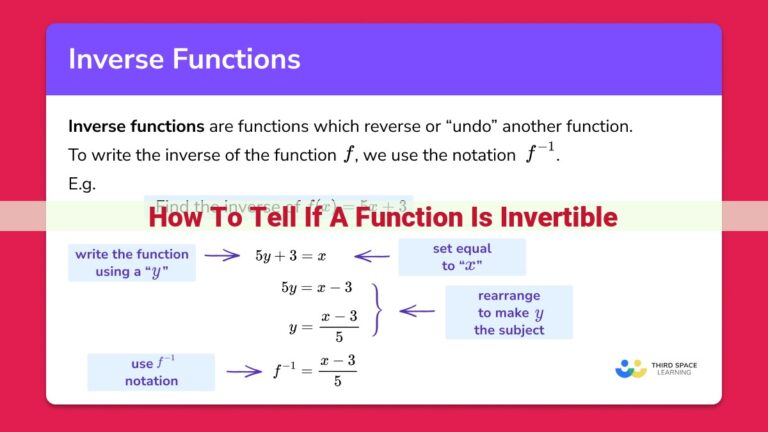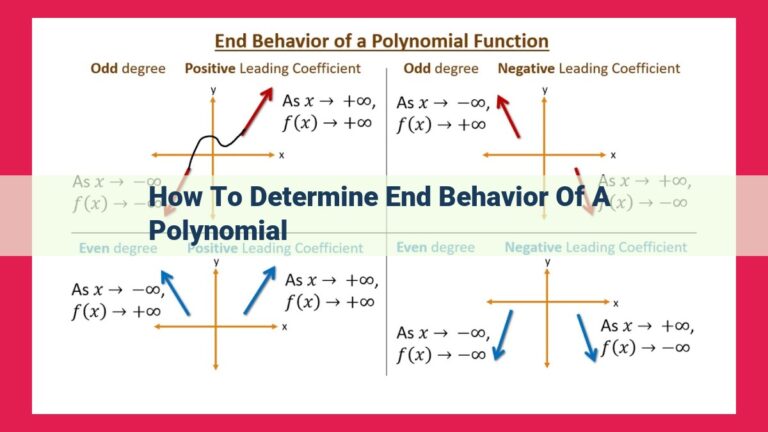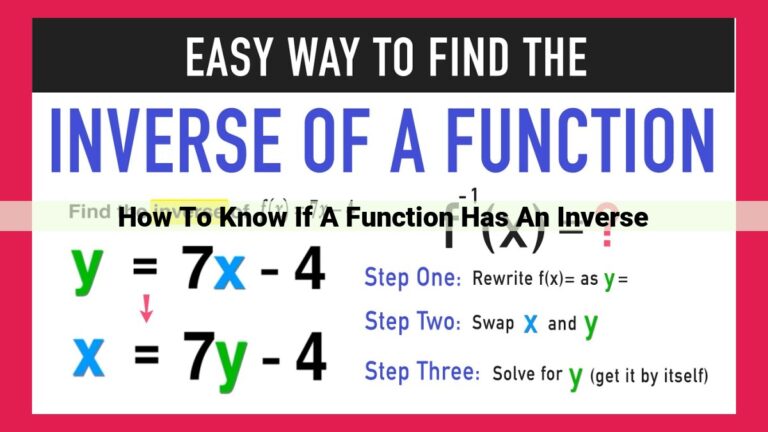Understanding Bijective Functions: Proving Surjectivity (Onto)

To prove a function onto, demonstrate that for every element in the codomain, there exists a corresponding element in the domain. Direct proofs establish this existence, while indirect proofs assume the opposite and lead to a contradiction. Existence proofs align with universal mappings, where every element in the domain maps uniquely to the codomain.
Onto Functions: The Gateway to Mathematical Significance
In the realm of mathematics, functions play a pivotal role. They are relations that associate each element of one set, called the domain, with exactly one element of another set, known as the codomain. Among these functions, onto functions stand out as essential tools in various mathematical applications.
Onto functions, also referred to as surjective functions, possess a unique characteristic. For every element in the codomain, there exists at least one element in the domain that maps to it. In other words, no element in the codomain is left uncovered.
The significance of onto functions lies in their ability to establish a comprehensive mapping. They ensure that every element in the codomain is accounted for. This property is particularly important in situations where it is crucial to guarantee that no element is overlooked or left behind.
Surjective Functions: The Essence of Mapping Every Element
Picture this: you’re at a party with lots of people. You know that each person there has a distinct name. If you’re tasked with collecting everyone’s names, your goal is to ensure that every person has their name written down. This means that every person has a corresponding name, and no names are left out. This is the essence of a surjective function.
In mathematical terms, a surjective function is a mapping from one set (the domain) to another set (the codomain) that satisfies the following condition: for every element in the codomain, there exists at least one element in the domain that maps to it.
Imagine this function as a chef cooking dishes at a restaurant. The menu (the codomain) lists all the dishes available. The chef (the function) prepares each dish. If every dish on the menu is cooked, then the chef’s function is surjective. Every element (dish) in the codomain (menu) has a corresponding element (cooked dish) in the domain (chef’s cooking).
Proving Surjective Functions: Unraveling the Two Approaches
In the realm of mathematics, functions reign supreme. One particular type of function, the surjective function, demands our attention. Surjective functions possess a unique characteristic: every element in the codomain (the set of possible output values) has a corresponding element in the domain (the set of possible input values).
To prove that a function is onto, we embark on a mathematical journey armed with two powerful approaches: direct proof and indirect proof.
Direct Proof: The Path of Existence
With a direct proof, we take the existence route. We set out to demonstrate that for every element in the codomain, there exists at least one element in the domain that maps to it. This approach involves constructing a mapping, a concrete way of showing that the correspondence between domain and codomain is complete.
Indirect Proof: Embracing the Impossible
The indirect proof method, on the other hand, takes the contradiction route. We begin by assuming that the function is not onto, meaning there’s an element in the codomain that has no corresponding element in the domain. Then, we embark on a logical dance, showing that this assumption leads to a contradiction. By proving that the negation of our assumption is false, we establish the truth of the original assertion, namely, that the function is onto.
Example:
Consider the function f(x) = x^2, where x and f(x) are real numbers. To prove that f is onto, we can use either approach.
Direct Proof:
For any y in the codomain (the set of possible output values), we can find an x in the domain (the set of possible input values) such that f(x) = y. Specifically, x = sqrt(y).
Indirect Proof:
Assume f is not onto. Then there exists a number y in the codomain such that for all x in the domain, f(x) ≠ y. This contradicts the fact that f is a function, since for every input x, there must be a unique output f(x).
In conclusion, proving surjective functions requires a combination of logical reasoning and creativity. By embracing both the direct and indirect proof methods, mathematicians have developed a powerful toolkit for unraveling the mysteries of onto functions and their applications in the wider world of mathematics.
Direct Proof: Showcase the Existence
In the mathematical realm of functions, proving that a function is onto is an essential task. One compelling way to accomplish this is through a direct proof, a strategy that elegantly demonstrates the function’s ability to reach every element in its codomain.
At the heart of a direct proof lies the concept of existence proofs. These proofs meticulously establish the presence of a specific element or property within a given set or context. In the case of onto functions, the existence proof aims to demonstrate that every element in the codomain is mapped to by at least one element in the domain.
To construct a direct proof of a function’s surjectivity, one must embark on a step-by-step journey that convincingly establishes this all-encompassing reach. The path begins by selecting an arbitrary element, denoted as y, from the codomain. This element represents any and every possible outcome that the function might produce.
With y firmly in hand, the next step involves meticulously examining the function. The objective is to unearth an element, x, in the domain that, when fed into the function, magically transforms into our chosen y. This crucial step effectively demonstrates that y is not an orphaned element in the codomain; it has a welcoming home in the domain.
By skillfully navigating these steps, a direct proof not only verifies the existence of a domain element that maps to each codomain element but also paints a vivid picture of the function’s ability to cover every nook and cranny of its codomain. This elegant approach transforms the abstract concept of surjectivity into a tangible reality, providing a solid foundation for understanding and working with onto functions.
Indirect Proof: Unveiling the Truth Through Contradiction
In the realm of mathematics, sometimes the path to truth lies not in proving directly, but in assuming the opposite and leading it to a logical dead-end. This is the essence of indirect proof, also known as proof by contradiction.
Imagine a detective investigating a crime scene. Instead of searching for evidence that proves the suspect’s guilt, they might assume the suspect’s innocence and try to find inconsistencies that contradict that assumption. If they find such contradictions, the assumption of innocence must be false and the guilt of the suspect is established.
Similarly, in mathematics, we can assume the negation of the statement we want to prove. If we can find a logical contradiction arising from this assumption, it means the original statement must be true.
For instance, to prove that a function f(x) is onto, we could assume the opposite: that there exists an element y in the codomain that is not mapped to by any element in the domain. We would then try to derive a logical contradiction from this assumption.
Scenario 1:
If f(x) is not onto, then for some y in the codomain, there is no x in the domain such that f(x) = y. Let’s try to find a contradiction.
-
Assume that
f(x)is not onto, so there exists anyin the codomain for whichf(x) ≠ yfor allxin the domain. -
Derive a contradiction: Since
f(x)is a function, it maps eachxin the domain to a unique element in the codomain. So, iff(x) ≠ yfor allx, it means thatyis mapped to by noxin the domain. This contradicts our assumption that every element in the codomain has a corresponding element in the domain.
Since our assumption led to a contradiction, it must be false. Therefore, the original statement must be true: f(x) is an onto function.
Related Concepts: Existence Proof and Universal Mapping
- Discuss the connection between existence proofs and universal mappings, where every element in the domain maps to a unique element in the codomain.
Existence Proofs and Universal Mappings: Ensuring Uniqueness
As we delve deeper into the world of onto functions, we encounter two related concepts that play a crucial role in establishing their unique properties: existence proofs and universal mappings.
Existence Proofs
An existence proof is a powerful tool in mathematics that demonstrates the existence of an object or property without explicitly constructing it. In the context of onto functions, an existence proof establishes that for every element in the codomain (the set into which the function maps), there exists at least one element in the domain (the set from which the function maps) that maps to it.
Universal Mappings
A universal mapping, also known as an onto function, takes things a step further by guaranteeing that every element in the domain maps to a unique element in the codomain. This means that each element in the codomain has a corresponding and distinct element in the domain that maps to it.
The Connection
The connection between existence proofs and universal mappings lies in their ability to establish the existence of a mapping from every element in the domain to the codomain. An existence proof demonstrates that such a mapping exists, while a universal mapping ensures that this mapping is unique for each element in the domain.
In other words, an existence proof guarantees that for every element in the codomain, there is at least one element in the domain that maps to it. A universal mapping goes beyond this to ensure that each element in the domain maps to exactly one element in the codomain. This unique mapping property distinguishes universal mappings from other types of functions.
Universal Mapping: Guaranteeing Uniqueness
In the realm of mathematics, functions play a pivotal role in mapping elements from one set to another. Among these functions, onto functions stand out as a special class, characterized by their all-encompassing nature. Each element in their codomain (range) is guaranteed to have a corresponding companion in the domain.
To visualize this concept, imagine a function as a bridge connecting two islands, the domain and the codomain. Universal mappings are the meticulous architects of this bridge, ensuring that each inhabitant of the domain has a unique house on the codomain. Every element from the domain finds its exclusive match, creating a harmonious one-to-one relationship.
This uniqueness is a fundamental property of onto functions, ensuring that no two elements from the domain share the same abode in the codomain. Each element of the domain has its distinguished identity, never to be confused with another.
Example: Consider a function that maps students in a class to their favorite subjects. For each student, there is a distinct subject they cherish. This function is a universal mapping, ensuring that every student has their own unique choice.
In conclusion, universal mappings are the guardians of exclusivity in the world of functions. They guarantee that each element in the domain has its own special counterpart in the codomain, creating a realm of one-to-one correspondence.





